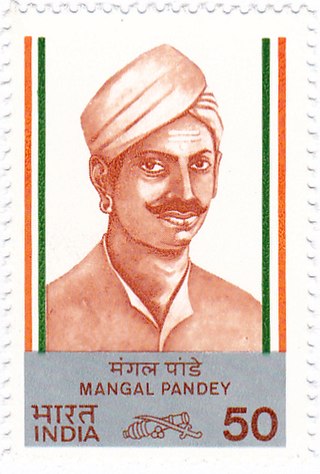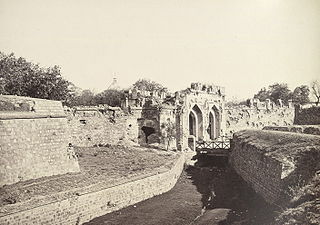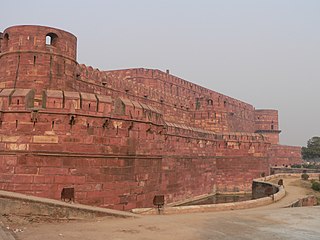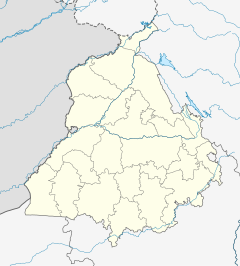
Mutiny is a revolt among a group of people to oppose, change, or remove superiors or their orders. The term is commonly used for insubordination by members of the military against an officer or superior, but it can also sometimes mean any type of rebellion against any force. Mutiny does not necessarily need to refer to a military force and can describe a political, economic, or power structure in which subordinates defy superiors.

The Indian Rebellion of 1857 was a major uprising in India in 1857–58 against the rule of the British East India Company, which functioned as a sovereign power on behalf of the British Crown. The rebellion began on 10 May 1857 in the form of a mutiny of sepoys of the company's army in the garrison town of Meerut, 40 mi (64 km) northeast of Delhi. It then erupted into other mutinies and civilian rebellions chiefly in the upper Gangetic plain and central India, though incidents of revolt also occurred farther north and east. The rebellion posed a military threat to British power in that region, and was contained only with the rebels' defeat in Gwalior on 20 June 1858. On 1 November 1858, the British granted amnesty to all rebels not involved in murder, though they did not declare the hostilities to have formally ended until 8 July 1859.

Nana Saheb Peshwa II, born as Dhondu Pant, was an Indian aristocrat and fighter, who led the rebellion in Cawnpore (Kanpur) during the 1857 rebellion against the East India Company. As the adopted son of the exiled Maratha Peshwa Baji Rao II, Nana Saheb believed that he was entitled to a pension from the Company, but as he was denied recognition under Lord Dalhousie's doctrine of lapse, he initiated a rebellion. He forced the British garrison in Kanpur to surrender, then murdered the survivors, gaining control of the city for a few days. After a British force recaptured Kanpur, Nana Saheb disappeared, with multiple conflicting accounts existing of his further life and death.

Mangal Pandey was an Indian soldier who played a key role in the events taking place just before the outbreak of the Indian rebellion of 1857. He was a sepoy (infantryman) in the 34th Bengal Native Infantry (BNI) regiment of the British East India Company. In 1984, the Indian government issued a postage stamp to remember him. His life and actions have also been portrayed in several cinematic productions.

The siege of Cawnpore was a key episode in the Indian rebellion of 1857. The besieged East India Company forces and civilians in Cawnpore were duped into a false assurance of a safe passage to Allahabad by the rebel forces under Nana Sahib. Their evacuation from Cawnpore thus turned into a massacre, and most of the men were killed and women and children taken to a nearby dwelling known as Bibighur. As an East India Company rescue force from Allahabad approached Cawnpore, 120 British women and children captured by the rebels were butchered in what came to be known as the Bibighar Massacre, their remains then thrown down a nearby well. Following the recapture of Cawnpore and the discovery of the massacre, the angry Company forces engaged in widespread retaliation against captured rebel soldiers and local civilians. The murders greatly enraged the British rank-and-file against the Sepoy rebels and inspired the war cry "Remember Cawnpore!".

General Bakht Khan (1797–1859) was the commander-in-chief of the Indian rebel forces in the city of Delhi during the Indian Rebellion of 1857 against the East India Company.

The Siege of Delhi was one of the decisive conflicts of the Indian Rebellion of 1857. The rebellion against the authority of the East India Company was widespread through much of Northern India, but essentially it was sparked by the mass uprising by the sepoys of the Bengal Army, which the company had itself raised in its Bengal Presidency. Seeking a symbol around which to rally, the first sepoys to rebel sought to reinstate the power of the Mughal Empire, which had ruled much of the Indian subcontinent in the previous centuries. Lacking overall direction, many who subsequently rebelled also flocked to Delhi.
Ajnala is a town, near Amritsar city and a nagar panchayat in Amritsar district in the state of Punjab, India. Kalian Wala Khuh, a martyrs place, is a tourist destination.
Historians have identified diverse political, economic, military, religious and social causes of the Indian Rebellion of 1857.

The 1915 Singapore Mutiny, was a mutiny of elements of the British Indian Army's 5th Light Infantry in the colony of Singapore. Up to half of the regiment, which consisted of Indian Muslims predominantly from Muslim Rajput background, mutinied on 15 February 1915 due to rumours that they would be sent to fight against the largely Muslim Ottoman Empire as part of the Middle Eastern theatre of World War I. The mutineers killed 36 soldiers and civilians before the mutiny was suppressed by Allied forces. After the mutiny, more than 205 mutineers were tried by court-martial, and 47 were sentenced to execution by firing squad.

The Battle of Badli-ki-Serai was fought early in the Indian Rebellion of 1857, or First War of Indian Independence as it has since been termed in Indian histories of the events. A British and Gurkha force defeated a force of sepoys who had rebelled against the British East India Company. The British victory allowed them to besiege and ultimately capture Delhi.

The Battle of Agra was a comparatively minor but nevertheless decisive action at the end of a prolonged siege during the Indian Rebellion of 1857.
The Indian Rebellion of 1857 has been variously termed as a war of independence, a rebellion, and a mutiny. Several Indian writers, who consider it as a part of the Indian independence movement that ultimately led to the country's independence in 1947, have termed it as "The First War of Independence", the "great revolution", the "great rebellion", and the "Indian freedom struggle". Several British writers, who view it as a military disturbance, have termed it as "sepoy revolt", "sepoy war", "Indian rebellion", and the "great revolt". Since the 19th century, a section of British writers have challenged the choice of the word "mutiny" to describe the events.

The Battle of Najafgarh was a subsidiary engagement of the Siege of Delhi during the Indian Rebellion of 1857. A large Indian force sortied from Delhi, intending to attack the rear of the British force besieging the city. A detachment from the besiegers marched to intercept them, and defeated them while they were disordered by difficult terrain and by quarrels among their commanders.

The Vellore mutiny, or Vellore Revolution, occurred on 10 July 1806 and was the first instance of a large-scale and violent mutiny by Indian sepoys against the East India Company, predating the Indian Rebellion of 1857 by half a century. The revolt, which took place in the Indian city of Vellore, lasted one full day, during which mutineers seized the Vellore Fort and killed or wounded 200 British troops. The mutiny was subdued by cavalry and artillery from Arcot. Total deaths amongst the mutineers were approximately 350; with summary executions of about 100 during the suppression of the outbreak, followed by the formal court-martial of smaller numbers.
Frederick Henry Cooper (1827–1869) was a British civil servant who worked with the East India Company. He served as Deputy Commissioner of Amritsar, Punjab, during the Indian rebellion of 1857.
During the Indian Rebellion of 1857 a column of troops led by the commander of the 24th Regiment of Foot was sent to disarm Bengal Native Infantry units believed to be at risk of mutiny in Rawalpindi and Jhelum. At Rawalpindi, the 58th Bengal Native Infantry was disarmed peacefully, however the two companies of the 14th Bengal Native Infantry resisted the attempt by force of arms. These two companies were quickly defeated by the British, loyal native troops and the local population. In Jhelum, also garrisoned by the 14th, the concurrently timed disarmament was much more violent. Thirty five British soldiers of the 24th Regiment of Foot were killed along with a number of Loyal Indian troops, by mutinous sepoys of the 14th Bengal Native Infantry. When the mutineers realised that they, except the Sikhs, were to be disarmed, they mutinied and made a vigorous defence against the force that had arrived from Rawalpindi to disarm them. The following night a significant number of mutineers managed to slip away but most were subsequently arrested by the Kashmir authorities, into whose territory they had escaped.

The Barrackpore mutiny was a rising of native Indian sepoys against their British officers in Barrackpore in November 1824. The incident occurred when the British East India Company was fighting the First Anglo-Burmese War (1824–1826) under the leadership of the Governor-General of Bengal, William Amherst, 1st Earl Amherst.

The Skull of Alum Bheg: The Life and Death of a Rebel of 1857, is a book by Kim A. Wagner, a lecturer on colonial India and the British Empire. It was published in 2017 by C. Hurst & Co., and is based on the life of Havildar Alum Bheg, a sepoy of the 46th Regiment of the Bengal Native Infantry, who following the Indian Rebellion of 1857 and being said to have killed a British missionary family in Punjab, was executed by the British by being blown from a cannon.

Rajab Ali Khan, also known as HavildarRajab Ali, was a soldier of the Bengal Regiment who defected during the Sepoy Revolt of 1857. He commanded the rebels at Chittagong and was chased by British forces as far as Sylhet and Manipur.



















